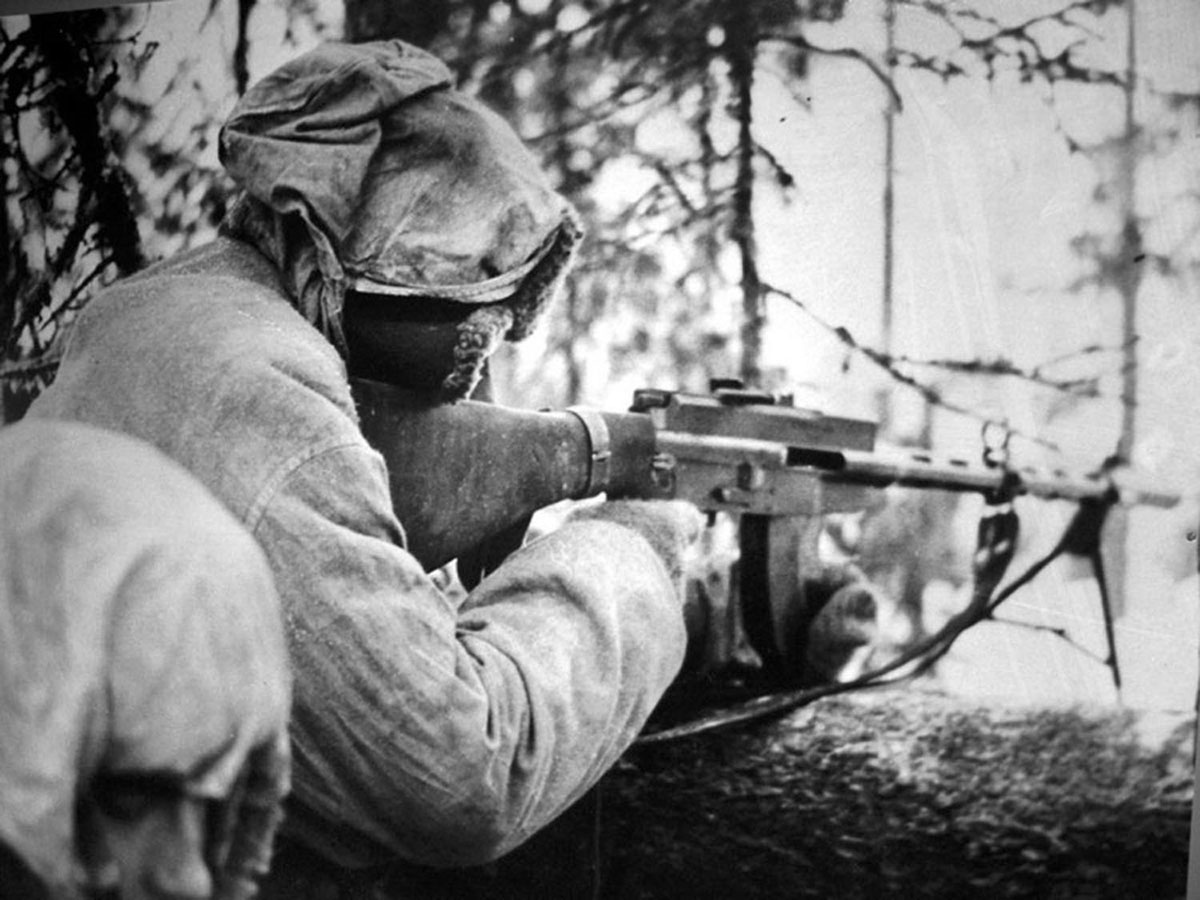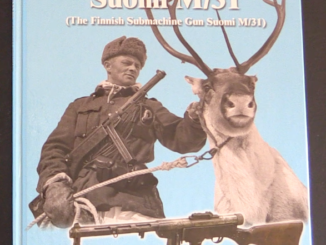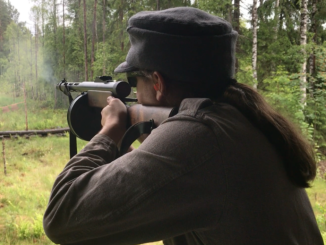
Finnish soldier with an LS-26 light machine gun, 1940.

Finnish soldier with an LS-26 light machine gun, 1940.

Michael Heidler’s bi-lingual (German and English) book on the Finnish Suomi m/31 submachine gun is a small but dense history of one of the best submachine guns of World War Two. It covers Aimo Lahti’s […]

Designed by Finland’s most notable arms inventor, Aimo Lahti, the m/31 Suomi submachine gun is an iconic weapon of the Winter War and the Continuation War. It is a first-generation submachine gun with a […]

Finnish dog wearing a canine gas mask during the Winter War.
© 2025 Forgotten Weapons.
Site developed by Cardinal Acres Web Development.

Given that this particular machine gun was ludicrously complicated (188 parts total), too heavy for its small magazine capacity, and considered unreliable in dirty conditions (needs special winter oil), would the gunner toss it for a DP-28 if he had the chance? Unless he is a great marksman, he is going to hate his weapon…
Finnish Gunner upon seeing incoming Russians: “Great, I can get a better weapon when they sit around the nice, warm camp fire…”
Not many Lahti-Saloranta LMGs were tossed during the Winter War, because there was a serious shortage of LMGs. So, if the gunner found a DP-28 that its former user no longer needed, he would hive the LS-26 to the next squad which had no LMG (this was in fact the official TO&E; half of the infantry squads had an SMG but no LMG and vice versa) and take the DP-28 to his own use. In 1941 and 1942 so many DP-28s were captured that most of the front line infantry could be equipped with them (one per squad) and the LS-26s were given to the same people who often also had the “joy” to operate the Carcano M38 rifles in 7.35x51mm 😀
The real issue with the reported reliability problems of the LS-26 was never fully resolved. Aimo Lahti was adamant that if properly maintained the reliability of the weapon was satisfactory. One definite issue during the Winter War was a failure to remove all storage greases (Cosmoline) thoroughly from many weapons, which of course lead to malfunctions. However, many gunners claimed later that it was not the only issue with the gun. According to them, in dusty conditions it would jam often no matter how well it was cleaned and oiled.
Then of course there was the small magazine. Although the magazines were easy to change and carry, most gunners still preferred the 47 round “pan” magazines of the DP-28, even though they were awkward to carry and slow to change. The DP-28 was very reliable under all conditions. A common joke was that it would function better if you shoveled some sand on it before use.
To sum it up, the LS-26 was not bad enough to be a real “lemon”, such as for example the Breda M30 LMG, but neither was it a truly good weapon.
There were special device to make loading DP magazines faster – the Rakov device:
https://www.forgottenweapons.com/rakov-dp-28-magazine-loader/
Also the tank-mounted version (DT machine gun) has improved 63-round magazines which has smaller diameter, but was taller.
Unfortunately finnish army was playing ground of differentkind of political poeple and soldiers who just knew better – We had actually much better and cheaper LMG in hands, but just because we did not get it. Half a price and gasoperated Lahti 7,62 mm light machinegun L-34 “Sampo”.
Is the L-34 Sampo action comparable to the BREN or ZB-26?
That seems to be a constant of most ordnance departments. Never go with cheap, simple and reliable if there’s a complicated, expensive and unreliable alternative.
While the L-34 was almost certainly the better weapon, the LS-26 was selected years before the L-34 was even designed and its production had just started. Armies are usually quite reluctant to change designs very often, so conservatism was to be expected. Politics and personal financial interests may have played a role, but how much is an open question. The primary source for those accusations is Aimo Lahti himself, but his claims were never corroborated by other people. Lahti was certainly a great weapons designer, but he also had a axe to grind in this matter. The official reason for the rejection of the L-34 was that since the L-34 was not belt or strip fed, it did not provide sufficient increase in firepower compared to the LS-26 to warrant changes in production.
Reminds me of my Swiss PE57. I guess the Swiss did not go too far from this concept. Every rifleman a machine-gunner and a grenadier.
AJ, while you are basically right, PE 57 was the civilian version of the Swiss assault rifle without selective fire capability.
The military Sturmgewehr was the Stgw 57.
Indeed. If you disregard its weight, the LS-26 foreshadowed many of the attributes of the assault rifles & full-bore “battle rifles” of the latter half of the 20th Century. Straight-line bore to stock axis, selective fire, choice of 25-round box or (for sustained fire) 75-round flat “pan” magazine (equivalent to the RPK 75-round drum), folding bipod, etc.
Reduce its weight to around 10 pounds (aluminum receiver & lighter-contour barrel?) and give it a decently-graspable forend, and it would have been a good match for the StG57.
cheers
eon
Only the improved model LS-26/31 had the 75-round pan magazine provision. The standard magazine of the LS-26 was 20 (not 25) round box. Only a 50 gun pre-series of the M26/31 were manufactured for experimental purposes. The Finnish Army rejected the M26/31 for unknown reasons, so later they were converted back to standard LS-26 configuration and the pan magazine capability was deleted. No pan magazines were ever issued to or used by combat troops.
Excellent information and input from everyone so far. I might be wrong, and please correct me if I am, but I get the distinct impression that, outside of the excessive mechanical complication and large number of parts, the LS-26 may have been a little too far ahead of its time and therefore did not fit well within the existing combat usage philosophies of that time.
The LS-26 was designed to be a squad LMG similar to the Madsen and Chauchat, so nothing really that advanced or forward looking. It utilized short recoil operation, which by 1920s was a well established operating system for machine guns. The only really advanced feature was quick change barrel, although the relatively slow cyclic rate of fire (450-550 rpm) and low capacity magazine made that less useful than in some other weapons. It was also too heavy to be fired from the shoulder and had a considerable muzzle climb.
In short, the LS-26 was not Aimo Lahti’s finest hour. Saloranta, who was initially in charge of the production at VKT, also made some unauthorized changes to the design between selection trials and production, which according to him were aimed at improving reliability. Who knows what he was thinking, but when the changes were revealed, he nevertheless managed to ruin his career as a small arms designer. To this day it is not known if the changes actually worked like he hoped, amounted to nothing important, or were actually detrimental. His most damning error was that he did not extensively test the modified gun. In any case the changes delayed the start of the production.
Thanks for your perspective on this subject — it helped a lot.
It may be kind of an obscure question, but does anyone know if there was more than one version of the magazine?
A few years ago some AK builders found that Lahti mags could be adapted to the PSL with minimal work. Others followed, with mixed results – some could get 15 or so rounds in, some found the mags jammed at 5 or 6, a few said their surplus 54R was too long to fit into the mags at all, others claimed a full 20 rounds of 54R loaded fine.
It was determined that some surplus 54R was actually longer than Finnish 53R and caused problems, but results were mixed even when the ammunition wasn’t too long.
I was wondering if there was more than one version of the magazine, or more than one manufacturer, to account for the different experiences. My own new, never-used Lahti mag would get a wedgie at 8 rounds of Tula commercial 54R.
Ahh. This brings some memories, lying in -38 celsius trying to get fingers to move enough to fire the bloody rk-95.